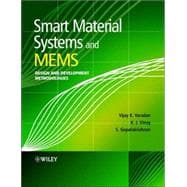
What is included with this book?
K. J. Vinoy is an Assistant Professor in the Department of Electrical Communication Engineering at the Indian Institute of Science, Bangalore, India. He received an M.Tech degree in Electronics from the Cochin University of Science and Technology, India and a Ph.D. degree in Engineering Science and Mechanics from the Pennsylvania State University, USA, in 1993 and 2002, respectively. From 1994 to 1998, he worked at the National Aerospace Laboratories, Bangalore, India. Following this, he was a research assistant at the Center for the Engineering of Electronic and Acoustic Materials and Devices (CEEAMD) at the Pennsylvania State University from 1999 to 2002. He continued there to carry out postdoctoral research from 2002 to August 2003. His research interests include several aspects of microwave engineering, RF-MEMS and smart material systems. He has published over 50 papers in technical journals and conference proceedings. His other publications include two books, namely Radar Absorbing Materials: From Theory to Design and Characterization, and RF-MEMS and their Applications. He also holds one US patent.
S. Gopalakrishnan received his Master’s Degree in Engineering Mechanics from the Indian Institute of Technology, Madras, Chennai, India and his Ph.D. degree from the School of Aeronautics and Astronautics, Purdue University, USA. He joined the Department of Aerospace Engineering at the Indian Institute of Science, Bangalore, India in November 1997 as Assistant Professor and is currently an Associate Professor in the same department. His areas of interest include structural dynamics, wave propagation, computational mechanics, smart structures, MEMS and nanocomposite structures. He is a Fellow of the Indian National Academy of Engineering and a recipient of the ‘Satish Dhawan Young Scientist Award’ for outstanding contributions in Aerospace Sciences from the Government of Karnataka, India. He serves on the editorial board of three prime international computational mechanics journals and has published 70 papers in international journals and 45 conference papers.
|
|||
|
|||
| PART 1: FUNDAMENTALS. | |||
|
|||
|
|||
|
|||
|
|||
|
|||
|
|||
|
|||
|
|||
|
|||
|
|||
|
|||
|
|||
|
|||
|
|||
|
|||
|
|||
|
|||
|
|||
|
|||
|
|||
|
|||
|
|||
|
|||
|
|||
|
|||
|
|||
|
|||
|
|||
|
|||
|
|||
|
|||
|
|||
|
|||
|
|||
| PART 2: DESIGN PRINCIPLES. | |||
|
|||
|
|||
|
|||
|
|||
|
|||
|
|||
|
|||
|
|||
|
|||
|
|||
|
|||
|
|||
|
|||
|
|||
|
|||
|
|||
|
|||
|
|||
|
|||
|
|||
|
|||
|
|||
|
|||
|
|||
|
|||
|
|||
|
|||
|
|||
|
|||
|
|||
|
|||
|
|||
|
|||
|
|||
|
|||
| PART 3: MODELING TECHNIQUES. | |||
|
|||
|
|||
|
|||
|
|||
|
|||
|
|||
|
|||
|
|||
|
|||
|
|||
|
|||
|
|||
|
|||
|
|||
|
|||
|
|||
|
|||
|
|||
|
|||
|
|||
|
|||
|
|||
|
|||
|
|||
|
|||
|
|||
|
|||
|
|||
|
|||
|
|||
|
|||
|
|||
|
|||
|
|||
|
|||
|
|||
|
|||
|
|||
|
|||
|
|||
|
|||
|
|||
|
|||
|
|||
|
|||
|
|||
|
|||
|
|||
|
|||
|
|||
|
|||
|
|||
|
|||
|
|||
|
|||
|
|||
|
|||
|
|||
|
|||
|
|||
|
|||
|
|||
|
|||
|
|||
|
|||
|
|||
|
|||
|
|||
|
|||
|
|||
|
|||
|
|||
|
|||
|
|||
|
|||
|
|||
|
|||
|
|||
|
|||
|
|||
|
|||
|
|||
|
|||
|
|||
|
|||
| PART 4: FABRICATION METHODS AND APPLICATIONS. | |||
|
|||
|
|||
|
|||
|
|||
|
|||
|
|||
|
|||
|
|||
|
|||
|
|||
|
|||
|
|||
|
|||
|
|||
|
|||
|
|||
|
|||
|
|||
|
|||
|
|||
|
|||
|
|||
|
|||
|
|||
|
|||
|
|||
|
|||
|
|||
|
|||
|
|||
|
|||
|
|||
|
|||
|
|||
|
|||
|
|||
|
|||
|
|||
|
|||
|
|||
|
|||
|
|||
|
|||
|
|||
|
|||
|
|||
|
|||
|
|||
|
|||
|
|||
|
|||
|
|||
|
|||
|
|||
|
|||
|
|||
|
|||
|
|||
|
|||
|
|||
|
|||
|
|||
|
|||
|
|||
|
|||
|
|||
|
|||
|
|||
|
|||
|
|||
|
|||
|
|||
|
|||
|
|||
|
|||
|
|||
|
|||
|
|||
|
|||
|
|||
|
|||
|
|||
|
|||
|
|||
|
|||
|
|||
|
|||
|
|||
|
|||
|
|||
|
|||
|
|||
|
|||
|
|||
|
|||
|
|||
|
|||
|
|||
|
|||
|
|||
|
The New copy of this book will include any supplemental materials advertised. Please check the title of the book to determine if it should include any access cards, study guides, lab manuals, CDs, etc.
The Used, Rental and eBook copies of this book are not guaranteed to include any supplemental materials. Typically, only the book itself is included. This is true even if the title states it includes any access cards, study guides, lab manuals, CDs, etc.